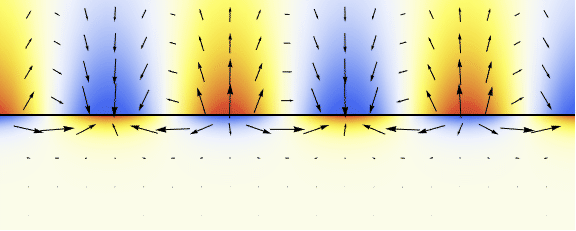Understanding Plasmonics in Nanotechnology
Definition: Plasmons are collective oscillations of free electron density, often in metals, triggered by electromagnetic waves. This interaction enables the concentration of light into exceedingly small volumes, far below the diffraction limit, making plasmonics a key pillar of nano-optics and nanophotonics.

Introduction to Plasmonics
At the intersection of nanotechnology and optics lies plasmonics, a specialized field that explores the intricate interactions between electromagnetic field waves and free electrons on metal surfaces. Plasmonics operates within the nanoscale range, typically between 1 and 100 nanometers, manipulating light in ways that challenge traditional optical limits and paving the way for groundbreaking technological advancements.
Plasmonics is a pivotal area within nanophotonics, a broader field that explores the manipulation and study of light on the nanometer scale. Nanophotonics encompasses a wide range of technologies designed to harness light for applications in computing, telecommunications, and sensing, among others. By understanding plasmonic interactions, scientists and engineers are able to design devices that exploit light-matter interactions at scales previously unattainable, contributing to the revolutionary advancements in nanophotonics. The synergy between plasmonics and nanophotonics opens up new pathways for developing ultra-compact and efficient photonic devices with capabilities far beyond traditional optics.
Nanoplasmonics, a term often used interchangeably with plasmonics, specifically refers to the study and application of plasmons at the nanoscale. This sub-field focuses on harnessing the unique properties of nano-sized metallic structures to control and manipulate light beyond the diffraction limit. Nanoplasmonics is at the heart of creating innovative solutions such as super-resolution imaging, highly sensitive biosensors, and enhanced photovoltaic devices. By precisely engineering the size, shape, and composition of nanoplasmonic structures, researchers can tailor their optical responses for specific applications, pushing the boundaries of what's possible in nanophotonics and beyond.
Understanding Plasmons
Plasmons arise when a light wave strikes a metallic surface, prompting the free electrons to oscillate in unison at a resonant frequency. This leads to the creation of surface plasmon polaritons (SPPs), waves that travel along the metal-dielectric interface, and localized surface plasmons (LSPs), confined to metallic nanoparticles.
Key Characteristics of Plasmons
Characterized by their ability to confine light to minuscule volumes, plasmons can enhance electromagnetic fields and enable strong light-matter interactions. These properties allow them to surpass the diffraction limit of light, facilitating super-resolution imaging and the development of highly sensitive biosensors.
Applications of Plasmonics
The unique features of plasmons have led to their application in diverse fields:
- Photovoltaics: Incorporating plasmonic nanoparticles into solar cells enhances light absorption and conversion efficiency.
- Sensors: The sensitivity of plasmonic materials to changes in their environment is exploited in the creation of biosensors and chemical sensors, offering high specificity and sensitivity.
- Optical Devices: Plasmonics is essential for developing compact, efficient optical devices like waveguides, modulators, and switches, which are crucial for integrated photonic circuits.
- Medical Therapeutics: Plasmonic nanoparticles are used in targeted drug delivery, photothermal therapy, and bio-imaging, leveraging their unique optical properties and heat generation capabilities.
Technological Advancements in Plasmonics
Advances in nanofabrication techniques have allowed for precise control over the size, shape, and composition of plasmonic structures, optimizing them for specific applications. The integration of plasmonics with other materials, such as 2D materials and quantum dots, opens new possibilities for enhancing device functionality and efficiency.
Challenges and Future Directions
Plasmonics faces challenges like ohmic losses in metallic components and the search for materials with improved plasmonic responses. Research is ongoing to find alternative materials, like doped semiconductors and conducting polymers, to overcome these limitations and broaden plasmonics??? applicability.
Environmental and Societal Impact
Plasmonics offers solutions for environmental monitoring and energy harvesting, contributing to sustainable development. Its impact on medical diagnostics and treatment underscores its potential for significant societal benefits.
Further Reading
Materials, Plasmonics and its Applications
